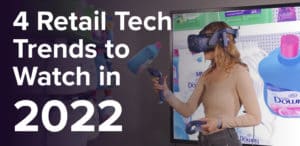3 Leading Grocery Industry Trends & New 2023 Retail Strategies

To differentiate, innovate, and defend their strategies, leading grocers need to make bold product decisions, invest in their people, and improve their digital capabilities by partnering with tech companies.
The grocery industry trends in 2022 were constantly evolving. As we look ahead further into 2023, there are three key grocery store trends driving change. First, inflation is impacting pricing and consumer purchasing decisions. Second, pandemic-related shifts in consumer behavior are accelerating, as shoppers continue to prioritize health, safety, and convenience. And third, the labor market is experiencing significant shocks that are affecting operations and supply chains.
In this blog, we'll delve into the key findings and explore strategies for retail business success in the face of these trends.
Top Grocery Industry Trends 2022-2023
1. Grocery Inflation
According to the United States Department of Agriculture, food prices in 2022 increased by 9.9 percent. Food-at-home prices (grocery inflation) in 2022 increased by 11.4 percent and food-away-from-home prices increased by 7.7 percent.
Insights from McKinsey & Company's "The state of grocery in North America" reports that this was driven by significant increases in labor, freight, and commodity costs in the latter half of 2021. Leading grocery retailers to raise prices while working to keep costs under control. With one of their interviewed CEO’s pointing out that "Inflation is exceeding customer income growth. If cost increases are just passed through, it will lead to lower sales and profits and a greater migration of customers to everyday low pricing (EDLP) grocers. It will be critical to balance when to absorb the cost inflation versus passing some or all of it through to optimize business performance and retain customers."
Today, statistics from March 2023 demonstrate grocery prices and overall inflation are continuing to slightly drop after hitting multi-decade highs last year. Experts from the Food Industry Association (FMI) expect food-at-home prices to continue tapering down, but grocers and their shoppers aren't likely to see lower prices on store shelves until at least 2024.

2. Consumer behavior grocery shopping changes
While some consumer behavior trends from 2022 are here to stay, there are a few changes impacting the year ahead. In today's grocery shopping trends, consumers are still facing higher prices from retail inflation and are looking for ways to stretch their budgets. As we've seen in grocery trends reports, consumer behavior in 2023 includes shoppers becoming more value-conscious, but they also care about eating healthier and buying sustainable products. This can create tension, since these options tend to be more expensive.
Despite this, we're seeing consumers make trade-offs and adjust their purchasing habits. Lower-income households are more likely to trade down and seek out cheaper options and promotions, while still buying some healthy and sustainable products. Meanwhile, higher-income households are continuing to spend more on these premium items. As a result, we're seeing growth at both the bottom and top ends of the assortment, with the brands in the middle losing out.
Additionally, grocers are facing a high bar for delivering value and consumers are unwilling to compromise on freshness. This presents a challenge for retailers, who must find ways to meet these expectations while also managing rising costs. In particular, e-commerce and related services are in high demand, adding to grocers' expenses. Despite these challenges, it's clear that consumers remain focused on both value and quality, and retailers must find ways to deliver on both fronts.

3. Retail labor shortage & cost increase
In the United States, the Bureau of Labor Statistics reports the grocery industry to be a major employer with 2.7 million people working across the various operations. However, the industry is facing significant upheaval in terms of its people model, from corporate roles to in-store positions. Absenteeism and attrition are on the rise, while employees are demanding more flexible scheduling.
As a result, retailers are looking for creative solutions to address these challenges. They are exploring new career paths for store managers and department managers, offering step-out roles and special projects to help broaden their skill sets. Offline learning and training programs are also being developed to help employees learn and develop beyond their current roles. With so many changes happening in the industry, it's clear that retailers must be proactive in adapting their people models to meet evolving demands.
Download the infographic
Easily share these insights! Get a free download of ReadySet's "3 Leading Grocery Industry Trends & New 2023 Retail Strategies" infographic.

What can retailers and brands do?
1. Make bold product moves
Shoppers are looking for both value and nutritious foods. About 40% are more focused on healthy eating and nutrition, and are planning to buy more local and regional foods (41%), high-protein items (34%), and goods without certain ingredients (33%). Millennials and Gen Z are especially interested in this combination of saving money and eating healthy, since their finances are still recovering. Grocers have a chance to meet this demand by including healthier, value-priced choices in their private-label products.
The emergence of this younger, value-conscious, and healthier eating consumer creates an opportunity for grocers to tailor their private-label products to include healthier options at a value price point. To thrive in the current environment, grocery retailers must make bold moves to adapt their offerings to meet the needs of consumers. The industry is experiencing dramatic shifts, including the polarization of consumers. Those who take bold steps to strengthen their offering for people seeking both value and premium-quality, sustainable, healthy products will come out stronger.

2. Invest in your people
The COVID-19 pandemic has accelerated long-term trends in retail work, including the growth of e-commerce and convenience-oriented services, changing job requirements throughout the retail industry. With these changes, retail workers must now have more technical knowledge and training, requiring retailers to invest in upskilling their employees. Many retailers are already implementing training programs to upskill their workers in technology and data analytics, as they need workers who are capable of handling the new requirements of the industry. These changes reflect a shift in the industry's low-wage model, with employers needing to pay more for a different type of worker and figure out how to treat them better.
Investing in people is key to meeting evolving workforce requirements in the grocery industry. Upskilling workers can help with recruitment and retention by providing employees with valuable skills and career advancement opportunities, while also addressing labor shortages and improving overall job satisfaction. Strong leadership is needed to foster growth and development in all parts of an organization, from corporate centers to store employees. Several leading organizations have taken bold steps to reskill their employees to keep pace with changing demands:
- Target rolled out a new education program to attract workers that will cover the expenses of earning associate and bachelor's degrees at specific institutions. Furthermore, it will aid in the payment of graduate school fees.
- Walmart launched a global Walmart Academy that will provide training and development programs to over 2.3 million associates worldwide, focusing on developing on-the-job skills, growing future skills for associates, and building leadership skills for managers. The Academy aims to create one of the largest learning ecosystems in the world, offering both digital and in-person offerings and providing associates with career-driven training and development. Additionally, Walmart offers Live Better U, which pays for 100% of college tuition and books for associates in the U.S.
- Kroger announced that it will spend $770 million more on employee pay and benefits in 2023, which will be funded by cost savings such as increased technology usage. This comes after Kroger had already raised the average starting rate at the company to $18 an hour due to compensation investments since 2018.
- Costco raised its hourly minimum wage to $16 at the beginning of March 2021.
3. Adopt new digital capabilities
The retail digital transformation has become a crucial aspect for businesses looking to improve their competitiveness, increase customer engagement, and drive revenue growth. To stay ahead in the rapidly changing retail landscape, it's essential for businesses to invest in both digital capabilities and core competencies like cost savings, private-brand development, and store operations. Partnering with top retail technology companies can help to modernize operations and enhance capabilities.
For example, Albertsons Companies and Takeoff Technologies formed a strategic partnership to collaborate on the future of grocery micro-fulfillment centers (MFCs) to drive the future of e-commerce order fulfillment. Micro-fulfillment centers typically hold about 15,000 to 18,000 of the local market’s most popular products and increase productivity by up to ten times through improved speed, productivity, accuracy, and efficiency.
Virtual reality (VR) is revolutionizing the way grocery stores and brands approach product testing, store layout design, employee training, and customer engagement. By utilizing retail VR software, brands can create virtual grocery stores for testing new product ideas and store layouts without the need for expensive physical prototypes. Additionally, these virtual environments can provide effective employee training and engaging shopping experiences in life-size immersion.
One company that has successfully leveraged VR technology is Barilla, America's top pasta brand. Using immersive virtual reality, Barilla cost-effectively generated several pasta aisle reinventions for testing. Aisles were test-shopped to provide a winning design that increased category sales and conversion rates. With the use of VR technology, grocery stores can gain a competitive edge by better understanding their customers, improving their operations, and creating new and innovative shopping experiences.
Subscribe to our newsletter
Get our blogs and the latest retail news delivered to your inbox monthly.
Recent Posts
Virtual Cannabis Stores Deliver Better Retail Experiences
Virtual reality is being used to educate customers on cannabis products and establish a dispensary brand image. The cannabis industry is growing rapidly with the expectation that it will continue to do so as more states legalize. Research shows that the legal cannabis market will grow 20-30% per year to the price of 50 billion…
4 Retail Tech Trends to Watch in 2022
Modern retail checkout counters and virtual retail labs are 2022 technology trends shaping the retail industry over the next year. The continued turbulence of 2021 has left the retail industry with new consumer behaviors, labor shortages, supply chain issues and accelerated online solutions. As tech in retail becomes necessary to provide superior customer experiences, more…
How Retail is Using VR to Innovate Planograms Amid Product Shortage
The labor and product shortages in 2021 has made it difficult for stores to keep shelves stocked. Virtual reality is providing a collaborative space for innovation despite global supply chain realities. Pandemic induced supply chain issues and labor shortages in 2021 have changed retail experiences and strategies. Just as retailers were ramping up their assortments…






